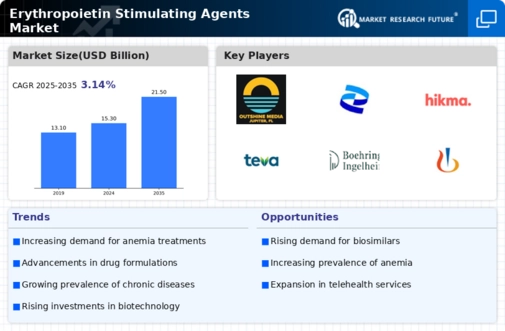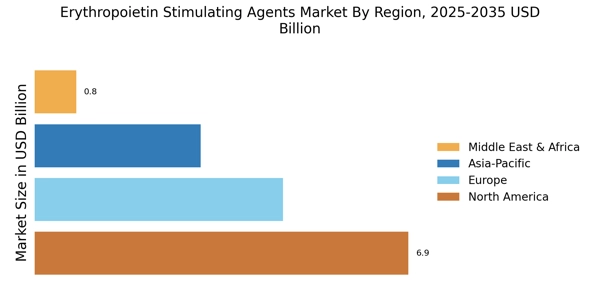Advancements in Biotechnology
Technological innovations in biotechnology are playing a pivotal role in shaping the Erythropoietin Stimulating Agents Market. The development of biosimilars has introduced cost-effective alternatives to traditional erythropoietin therapies, making treatment more accessible to patients. As of 2025, the biosimilars segment is expected to capture a significant share of the market, driven by their affordability and similar efficacy to original products. Additionally, advancements in drug delivery systems are enhancing the effectiveness of these agents, potentially leading to improved patient outcomes. The ongoing research and development efforts in biotechnology suggest a promising future for the Erythropoietin Stimulating Agents Market.
Rising Awareness and Screening Programs
Increased awareness regarding anemia and its implications has led to more proactive screening programs, thereby influencing the Erythropoietin Stimulating Agents Market. Healthcare organizations are implementing initiatives to educate both patients and providers about the importance of early detection and treatment of anemia. This heightened awareness is likely to result in a greater number of patients being diagnosed and treated with erythropoietin stimulating agents. As a result, the market is expected to witness a surge in demand, particularly in regions where anemia prevalence is high. The integration of screening programs into routine healthcare practices could significantly bolster the Erythropoietin Stimulating Agents Market.
Growing Investment in Healthcare Infrastructure
The expansion of healthcare infrastructure in various regions is contributing to the growth of the Erythropoietin Stimulating Agents Market. Increased funding for healthcare facilities and services is enabling better access to anemia treatments, including erythropoietin stimulating agents. As hospitals and clinics enhance their capabilities, the availability of these therapies is expected to improve, leading to higher patient enrollment in treatment programs. Moreover, the establishment of specialized centers for chronic disease management is likely to further drive the demand for erythropoietin therapies. This investment in healthcare infrastructure appears to be a crucial factor in the evolving landscape of the Erythropoietin Stimulating Agents Market.
Regulatory Support for Erythropoietin Therapies
Regulatory bodies are increasingly recognizing the importance of Erythropoietin Stimulating Agents Market in managing anemia associated with chronic diseases. Recent approvals of new formulations and biosimilars have provided a boost to the market, as these agents are essential for improving patient quality of life. Regulatory support not only facilitates the entry of innovative products but also ensures that existing therapies remain available to patients. The favorable regulatory environment is likely to encourage further investment in research and development, thereby enhancing the overall growth trajectory of the Erythropoietin Stimulating Agents Market.
Increasing Demand for Erythropoietin Stimulating Agents
The rising incidence of chronic diseases such as chronic kidney disease and cancer has led to an increasing demand for Erythropoietin Stimulating Agents Market. As these conditions often result in anemia, the need for effective treatment options has surged. According to recent estimates, the prevalence of chronic kidney disease is projected to affect approximately 15% of the adult population, thereby driving the demand for erythropoietin therapies. Furthermore, the aging population is more susceptible to these diseases, which further amplifies the market's growth potential. The Erythropoietin Stimulating Agents Market is thus positioned to expand as healthcare providers seek to address the anemia associated with these chronic conditions.


















Leave a Comment